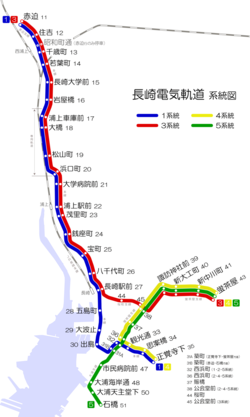Top Qs
Timeline
Chat
Perspective
Nagasaki Electric Tramway
Tram system in Nagasaki, Japan From Wikipedia, the free encyclopedia
Remove ads
The Nagasaki Electric Tramway (長崎電気軌道, Nagasaki Denki Kidō) is a private tram system in Nagasaki, Japan. Since March 20, 2008, its lines accept Nagasaki Smart Card, a smart card ticketing system.
This article needs additional citations for verification. (February 2024) |



The company was founded on August 2, 1914, while the tram line was opened on November 16, 1915. It once operated bus lines as well, but went out from the division later in 1971. The company and the lines are commonly known as Nagasaki Electric Railway (長崎電鉄, Nagasaki Dentetsu). Locals also call them the electric train (電車, densha), while JR lines are called JR, the train cars (列車, ressha), or the locomotive train (汽車, kisha).
The lines are stably making profits and they are the only tramway operator in Japan that has not lost any of its original lines.
Remove ads
Fares
The current fare is ¥150 for adults and ¥80 for elementary school aged children and can be paid by cash (on exit, paid to the driver) or by IC card.[1] Free transfers are only available when payment is by IC card.
Short-Distance Fare for up to two segments of track is ¥100 for adults and ¥50 for children, and is only available with payment by one of the 10 Nationwide Mutual Usage IC cards, including nimoca.[1]
One-day pass giving unlimited rides is ¥600 for adults and ¥300 for children. This pass is not sold onboard trams, it must be purchased from outlets including: Nagasaki Station Tourist Information Center, JR Kyushu Nagasaki Station Midori no Madoguchi, tramway sales offices and selected hotels.[2]
One-day pass (¥600 for adults / ¥300 for children), as well as 24-hour pass (¥700 for adults / ¥350 for children), is available using a iPhone or Android smartphone on the Japan Transit Planner by Jorudan app in many languages including Japanese, English, Chinese, Korean & Thai.[1]
Remove ads
Line and routes
Summarize
Perspective
As is the case with most Japanese tram systems, the official "lines" differ from the "routes" that are currently operated. Both are shown below. Only interchangeable stations are shown.
- Lines: Officially, there are five lines totaling 11.5 km (7.1 miles).
- Main Line (本線): Sumiyoshi — Nagasaki-Ekimae — (Dejima) — Shinchi Chinatown — Nishihamano-machi — Sōfukuji
- Akasako Line (赤迫支線): Sumiyoshi — Akasako
- Sakuramachi Line (桜町支線): Nagasaki-Ekimae — (Sakuramachi) — Shiyakusho (City Hall)
- Ōura Line (大浦支線): Shinchi Chinatown — Ishibashi
- Hotarujaya Line (蛍茶屋支線): Nishihamanomachi — Shiyakusho (City Hall) — Hotarujaya
- Routes: There are five routes regularly in service over one or more lines. Route 2, however, only has 1 lap a day late at night (and is not generally shown on printed and online route information), and route 4 only runs in the morning and evening peaks. There are other temporary routes as well.
- ■ Route 1 (1系統): Akasako — Sumiyoshi — Nagasaki-Ekimae — (Dejima) — Shinchi Chinatown — Nishihamanomachi — Sōfukuji
- □ Route 2 (2系統): Akasako — Sumiyoshi — Nagasaki-Ekimae — (Dejima) — Shinchi Chinatown — Nishihamanomachi — Shiyakusho (City Hall) — Hotarujaya
- ■ Route 3 (3系統): Akasako — Sumiyoshi — Nagasaki-Ekimae — (Sakuramachi) — Shiyakusho (City Hall) — Hotarujaya
- ■ Route 4 (4系統): Hotarujaya — Shiyakusho (City Hall) — Nishihamanomachi — Sōfukuji
- ■ Route 5 (5系統): Hotarujaya — Shiyakusho (City Hall) — Nishihamanomachi — Shinchi Chinatown — Ishibashi
 purple:Akasako Line blue:Main Line green:Sakuramachi Line orange:Ōura Line pink:Hotaruchaya Line |
 blue:Route 1 red:Route 3 yellow:Route 4 green:Route 5 |
Remove ads
See also
References
External links
Wikiwand - on
Seamless Wikipedia browsing. On steroids.
Remove ads
